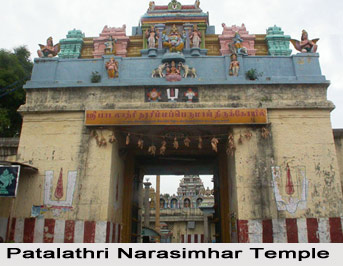 The inscription provides an added grandeur to the legendary greatness of Sri Pataladri Narasimhasvami Temple. There are a number of ancient, historical inscriptions written in Tamil, found etched in various parts of this temple. These inscriptions clearly points to the chronology and thereby points to the magnificence of the temple. The earliest of these, according to the historical researches dated 990 A.D. It has been discovered on the right pillar of the central facade of this rock-cut shrine, which belongs to the reign of Rajaraja I (985-1014 A.D.), the illustrious Chola emperor who ruled from his capital-city of Tanjavur over a large part of South India. This inscription moreover records the donation of twenty-six sheep for the maintenance of Azhvar Narasinga Vinnagar Devar by a person named Senda-Kutti.
The inscription provides an added grandeur to the legendary greatness of Sri Pataladri Narasimhasvami Temple. There are a number of ancient, historical inscriptions written in Tamil, found etched in various parts of this temple. These inscriptions clearly points to the chronology and thereby points to the magnificence of the temple. The earliest of these, according to the historical researches dated 990 A.D. It has been discovered on the right pillar of the central facade of this rock-cut shrine, which belongs to the reign of Rajaraja I (985-1014 A.D.), the illustrious Chola emperor who ruled from his capital-city of Tanjavur over a large part of South India. This inscription moreover records the donation of twenty-six sheep for the maintenance of Azhvar Narasinga Vinnagar Devar by a person named Senda-Kutti.
Another inscription dated 993 A.D., also of the reign of the same Chola monarch is considered important by the historical research. It records the registration of gift of land to this temple by a person named Ayyaran Nakkan for maintaining two lamps and for food offerings to Narasinga Vinnagar Azhvar. These two lamps were considered as the emblem of the contemporary ruler as the inscriptions depict. Another inscription belonging to the same year (993 A.D.) is found on the rock behind the Andal shrine is unfortunately damaged and incomplete, but appears very significant on close reading. It refers to some gift made by an individual to God Narasinga Vinnagar Azhvar of Chengunram.
The last of the epigraphs in this temple is found on the lower portion of the right pillar of the central-facade of the main shrine. It belongs to the 11th century A.D., but since it is much damaged, the details cannot be made out clearly. It is likely that this one too, like the previous inscriptions, records a donation made to this consecrated temple by the contemporary kings and kings` men.











